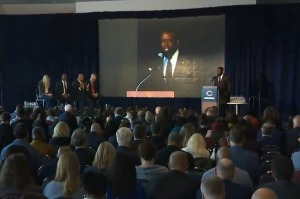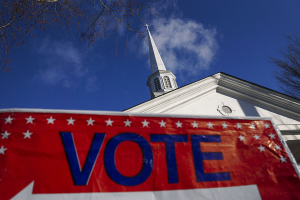Contrasting Views of Marriage: The Benefits of Same-Sex Marriage
This is the first in a five-part debate series on same-sex marriage between James W. Doig and Robert P. George. It originally appeared on The Witherspoon Institute's Public Discourse.
Dear Robby,
In thinking about the issue, "How should marriage be defined?" I want to begin with two Vermonters, Ann and Ellen, who have been together as a couple for more than thirty years. They have three children-Bert, who has graduated from college and is now married (to Maria) and working in a small business in Vermont, and Alison and Beth, who are in high school, both doing well in their academic work and excelling in soccer. One of the three is adopted, and Ann is the birth mother of the other two.
When Vermont passed a law in support of civil unions, Ann and Ellen joined up. When, a few years later, Canada permitted same-sex marriage (SSM), they were married in Montréal. In 2009, when Vermont accepted SSM as legal, they were married again, in Newbury. Both marriages were civil, not carried out in religious ceremonies.
What's wrong with this marriage? Here we have a long-term commitment-far longer than the average heterosexual marriage (HSM) in the US. And the three children appear to be well adjusted.
Referring to the text of your 2012 book, What Is Marriage?, their marriage is, I believe, "a bodily as well as an emotional and spiritual bond, distinguished thus by its comprehensiveness-flowing out into the wide sharing of family life and ahead to lifelong fidelity." It is "permanent and exclusive" and "its link to children's welfare makes marriage a public good that the state should recognize and support." I agree with your comment that "marriages have always been the main and most effective means of rearing healthy, happy, and well-integrated children," and that is why law "should recognize and support marriages." To me and to the many who know them, the marriage and life of Ann and Ellen affirm your point. I suppose (except for the absence of children) that the life together of Edith Windsor and Thea Spyer had much the same value for them and for those who knew them. (The Windsor case is discussed below.)
In contrast to the permanence and care for children that Ann and Ellen's life together illustrates, you describe the history of John and Carol, who were married, abandoned their spouses and children, and then married each other. Would it not make sense to prohibit using the term "marriage" in any such abandonment and further uniting? Perhaps they could be limited to having a "civil union," signaling society's reluctant approval. Which behavior is more acceptable morally-that of John and Carol or of Ann and Ellen? Based on the principles set forth in your book, I am inclined to applaud the marriage of Ann and Ellen and to conclude that the behavior of John and Carol deserves sharp criticism and perhaps condemnation.
Yet you are passionate about the need to strip marriage (and the many psychological and governmental benefits that follow) from Ann and Ellen and from the thousands who would enter into SSM. In addition, you would seem to accept the likelihood that unkind neighbors would label children of same-sex partners that you wish to see unwedded as "bastards."
You state that the purpose of your book is to show that laws limiting marriage to one man & one woman (HSM) are "rationally grounded." You argue that if marriage includes same-sex partners, "many" other folks will tend not to "understand or respect the objective norms of permanence or sexual exclusivity" that are essential. But that failure to understand and respect is widespread already in the community of heterosexual men and women, more than half of whom divorce their spouses. In addition, limiting marriage to one man and one woman has, historically, been closely tied to denying stability in sexual relationships for those who are gay and to using the police and other governmental powers to pursue and often imprison those who are drawn sexually to others of the same gender.
In your book, you argue that limiting marriage to one man and one woman need not require "denigrating same-sex-attracted people, or ignoring their needs." You affirm that "all human beings have equal moral dignity, equal basic rights under the law, and a right in justice against every invidious distinction." However, looking at your earlier writings, I am inclined to believe that you have come to this position with great reluctance and that, if you could rewrite recent judicial judgments and laws, you would return society to one in which those with same-sex orientations would need to be careful to avoid apprehension by the police or other guardians of "morality." Let me comment on those earlier writings, since they provide a route to understanding the moral compass that underlies your arguments regarding marriage and sexual relationships.
Your earlier views on Romer and on Griswold
I begin with your 1996 essay (with William Saunders) on Romer v. Evans, a 1996 decision that you characterize as "The Supreme Court's Assault on Popular Sovereignty." There you argue that "Amendment 2" to Colorado's constitution-which blocked local governments from providing special protections for homosexuals (similar to the protections already afforded to racial and ethnic minorities)-should have been upheld by the US Supreme Court. The Court, you assert, should have followed the 1986 precedent, Bowers v. Hardwick, "in which the justices upheld as constitutionally valid a state law forbidding, with force of criminal sanctions, homosexual conduct."
You go on to argue that the Court's action in Romer v. Evans "throws out the window one of the sure guarantors of our liberty-the principle of self-government . . . The court does not trust the people or the political process." This seems to me a very partial understanding of what happened in Colorado. You have passed over the fact that local governments in that state had, over several years, debated whether to provide legal protections-similar to those provided to racial and religious minorities-to those who are gay. Exercising their rights under the principle of self-government, the cities of Aspen, Boulder, and Denver had approved legislation that provided distinctive protection against bias based on sexual orientation. Fort Collins and Colorado Springs had debated similar measures and had rejected that approach.
Unwilling to accept this democratic process and the results in three of those cities, opponents from national as well as local groups-who favored the use of "criminal sanctions" against homosexual behavior (Bowers)-pressed for a state-wide referendum. That referendum sought to prohibit all local regulations and policies that would entitle a person alleging bias in housing or employment due to homosexual orientation to bring a claim of minority status or a "claim of discrimination" (Amendment 2, Colorado, 1993; emphasis added). I emphasize the final words in the Amendment, for they seem to suggest that the rights of homosexuals and bisexuals would be less favorably treated than those who allege bias due to age, veterans' status, or pregnancy.
Perhaps the strong endorsement of Amendment 2 that you and Saunders expressed in your 1996 essay no longer represents your view. Would you let me know whether or not you still hold the position found in that essay?
Your criticism of the Supreme Court decision in Romer states that Amendment 2 expressed "disapprobation of sexual immorality and 'alternative lifestyles' based on it." Disapproval, shading into hostility to gays, is conveyed in Justice Scalia's dissent in Romer and captured even more directly in the 1986 Court opinion in Bowers. That hostility provides at least a partial explanation for violent acts against gays and lesbians, acts which recall the violence against African-Americans that characterized much of the South in earlier years.
The similarity to the Southern lynching mentality was underscored by the fate of Matthew Shepard, who was stripped, tortured, and strung up on a barbed-wire fence in Laramie, Wyoming on October 6, 1998 and left to die. Found and taken to a hospital, he died of head injuries six days later. The young men who attacked and murdered Shepard were readily discovered, for they boasted of their "accomplishment" in a bar the next day. That Antonin Scalia was insensitive to the important issue of anti-gay bias that Colorado's local laws attempted to confront is not surprising; that your views seemed in tune with Scalia's is surprising to me.




























